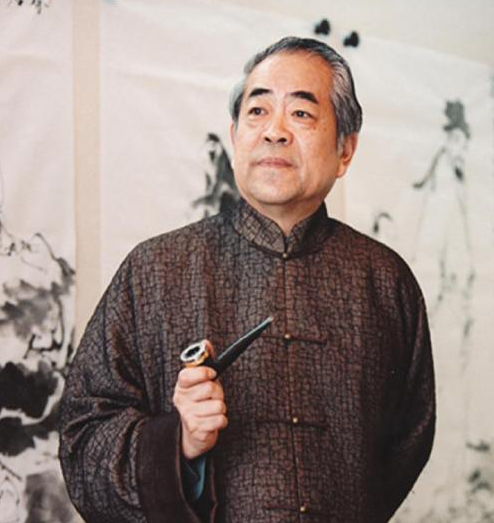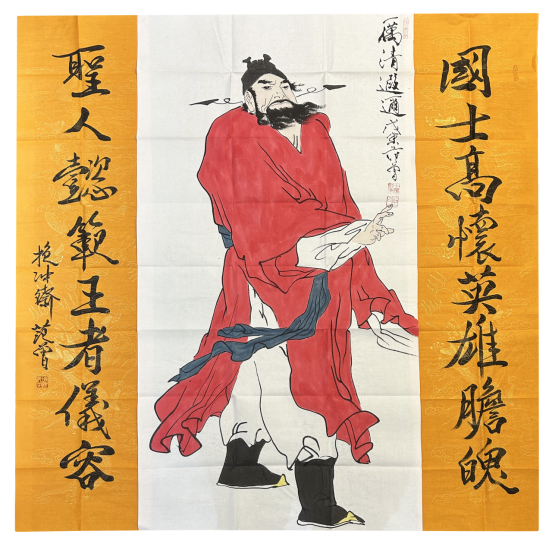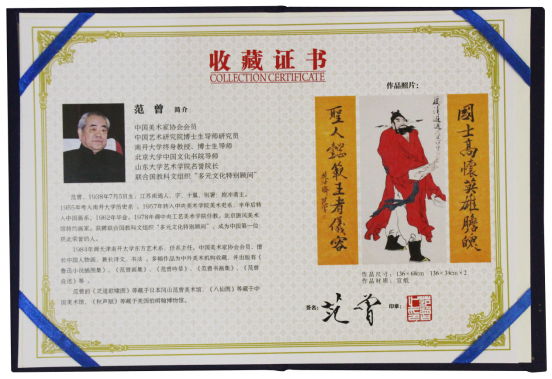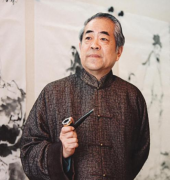范曾,字十翼,别署抱冲斋主,江苏南通人,中国当代著名学者、思想家、国学大师、书画巨匠、文学家、诗人。现任北京大学中国画法研究院院长,中国艺术研究院终身研究员,南开大学、南通大学惟一终身教授,联合国教科文组织“多元文化特别顾问”。为当代中国集诗书画、文史哲、儒释道于一身的文化大家,平生著作等身,有约一百五十种诗、书画、哲学之著述,国家图书馆珍藏其中119种。1984年日本冈山范曾美术馆建立;2007年南通大学范曾艺术馆揭牌。有二十四字自评:痴于绘画,能书;偶为辞章,颇抒己怀;好读书史,略通古今之变。开创了“新古典主义”艺术的先河,曾荣获中华艺文奖终身成就奖。
Fan Zeng, with the Chinese character Shiyi, also known as Hugong Zhaishi, a native of Nantong, Jiangsu Province, is a renowned contemporary Chinese scholar, thinker, master of the national academy, master of painting and calligraphy, writer and poet.Fan Zeng is currently the director of the Institute of Chinese Painting and Calligraphy at Peking University, a life-long researcher at the China Academy of Art, the only life-long professor at Nankai University and Nantong University, and a "special advisor on multiculturalism" at UNESCO.In 1984, Fan Zeng Art Museum was established in Okayama, Japan; in 2007, Fan Zeng Art Museum was inaugurated in Nantong University.There are twenty-four words of self-assessment: obsessed with painting, able to write; occasional rhetoric, quite expressive of their own feelings; good reading history, slightly through the ancient and modern changes.Fan Zeng pioneered the art of "neo-classicism" and was honored with the Lifetime Achievement Award of the China Arts and Letters Award.

钟馗可谓大众崇拜的神话人物,民间俗界有着可观的人缘人脉。古书记载他系唐初长安终南山人(据古籍记载及考证,钟馗故里为陕西省西安秦岭中段终南山下户县石井镇钟馗故里欢乐谷),生得豹头环眼,铁面虬鬓,相貌奇异;然而却是个才华横溢、满腹经纶的人物,平素正气浩然,刚直不阿,待人正直,肝胆相照。国画大师们历来不乏塑造钟馗的雅兴,五代黄筌、宋代石恪、元代龚开、明代戴进,清代则更多,有顾见龙、金农、华喦、罗聘、黄慎、李鱓、任颐、赵之谦等,近代著名画家齐白石、徐悲鸿、李可染、黄胄等,都拿出看家本领渲染涂鸦,各有侧重各有风格各有千秋。
Zhong Kui can be described as the public worship of the mythological figure, the folk community has a sizable network of people.Ancient books record that he is the Department of the early Tang Dynasty Chang'an Zhanshan Mountain people (according to ancient records and evidence, Zhong Kui hometown for the Xi'an, Shaanxi Province, Qinling Mountains, Zhanshan Mountain under the Huxian Shijing Town Zhong Kui hometown of Happy Valley), was born with a panther's head and ringed eyes, gnarled sideburns, looks strange; however, it is a talented, full of characters, plain righteousness and righteousness, uprightness and uprightness, treating people honestly and courageous.Masters of Chinese painting have always had a taste for portraying Zhong Kui, from Huang Chyuan in the Fifth Dynasty, Shi Ke in the Song Dynasty, Gong Kai in the Yuan Dynasty, Dai Jin in the Ming Dynasty, and many more in the Qing Dynasty, including Gu Gu Guimenglong, Jin Nong, Hua Yan, Luo Hai, Huang Shen, Li Jian and Zhao Zhiqian, to the more recent famous painters, such as Qi Baishi, Xu Beihong, Li Keran, and Huang Han, who have all come up with masterful renderings of Zhong Kui in a variety of different styles and styles.

范曾先生所绘钟馗,不同于古人,他把文与武两重形象同时赋予给钟馗,既给他以威猛,也给他以庄严。对这一传统题材作了独具匠心的艺术改造,即不去刻画钟馗将小鬼“刳目而啖之”的可怖,而着力表现其“内圣外王”的人文内涵。于是钟馗不再是凶恶骇人的“鬼”,而是有血有肉、有爱有憎的“人”,既端庄威严又可敬可亲。钟馗成为范曾艺术世界中的一个重要符号,给了他恒久的艺术生命。范曾画钟馗已有40年历史。他的威风凛然、精光四射的钟馗形象已广为世人所喜爱,他本人最初也因钟馗而声名鹊起。
Mr. Fan Zeng's painting of Zhong Kui is different from that of the ancients, in that he has given Zhong Kui both a literary and a martial image, giving him both majesty and solemnity.This traditional subject has made a unique artistic transformation, that is, instead of portraying the horror of Zhong Kui's "routing out the eyes and mouths" of the little ghosts, he focuses on expressing the humanistic connotation of his "inner saint and outer king".As a result, Zhong Kui is no longer a vicious and horrifying "ghost", but a "human being" with flesh and blood, love and hate, who is both dignified and majestic, as well as respectable and approachable.Zhong Kui has become an important symbol in Mr. Fan Zeng's art world, giving him a constant artistic life.Fan Zeng has been painting Zhong Kui for 40 years.His powerful and brilliant Zhong Kui image has been widely loved by the world, and he himself was initially famous for Zhong Kui.
文中的作品系范曾经典之作,画中用充满激情的画笔,寥寥几根线条以及衣物大面积的彩色准确而又生动地勾画出这位刚正不阿,正气浩然的中国传统文化中“赐福镇宅圣君”钟馗的形象。范曾有时会抓住钟馗的特点进行表现:此幅钟馗立身前行,人物相貌魁梧,五官端正,衣角飘逸,充分显出运动人物的动态。
The works in this article are Fan Zeng's classic works, in which he accurately and vividly sketches the image of Zhong Kui, the "blessing and house-keeping saint" of traditional Chinese culture, with passionate brushes, a few lines, and large areas of color in his clothing.Fan Zeng sometimes captures the characteristics of Zhong Kui in his performance: in this painting, Zhong Kui is standing up and walking forward, with a stout appearance, straight features, and flowing clothes, fully revealing the dynamics of the moving figure.

最为精彩部分为人物神情的刻画,钟馗面部表情在胸有成竹的沉着中微微透露一种紧张和严肃,一只手臂微微抬起,也是其内心活动的写照。全图笔墨凝练生动,钟馗形象勾勒极致简化,成功地表现出钟馗的文人气质,既端庄威严,又可敬可亲。是范曾先生十分难得的人物画佳作。右方以及左右两侧题字书法,酣劲流畅,顿挫明快,给观者以无尽的享受,艺术价值不言而喻。
The most wonderful part of the character's expression, Zhong Kui's facial expression in the calm of the chest slightly revealed a kind of nervousness and seriousness, an arm slightly raised, but also a reflection of his inner activities.The ink and brushwork of the whole picture is condensed and vivid, and the image of Zhong Kui is outlined and simplified in the extreme, successfully showing the literati temperament of Zhong Kui, which is both dignified and majestic, but also respectable and approachable.This is one of Mr. Fan Zeng's rare masterpieces of figure painting.The calligraphy on the right and on the left and right sides of the inscription, sound and smooth, staccato and bright, giving the viewer endless enjoyment, the artistic value is self-evident.






